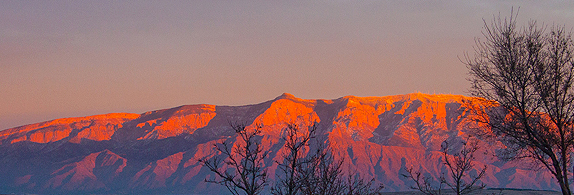
New Mexico holds a unique tricultural position in the history of the United States.
Although a modern reader might surmise that “New Mexico” is derived directly from the place name “Mexico,” as we now identify that modern country, it has instead a somewhat more complicated history.
Trinity stands for the Christian culture of the Spanish and later the Anglo Americans as well as for the Trinity site in White Sands, where the world’s first atomic bomb was detonated on July 16, 1945.
Seeing New Mexico as the Savage Reservation and, along with the rest of the arid West, as a national sacrifice zone, helps us to understand environmental racism.
Living in extraordinary times, and doing extraordinary things, these people have kept alive the possibilities that we have all but forgotten ever existed–the possibility for hope coming through simple faith, for change coming about through rituals, and for miracles.
The most important natural area in New Mexico exists wherever one goes in the state. It is the sky overhead.
One day, you can be sweltering in the desert backcountry of Carlsbad Caverns National Park, the next you can be shivering at an alpine lake as snow flurries shroud the peaks above.
When Captain E. F. Dutton and his party rode into this glorious country in the 1880s to survey it for the for the U.S. Geological Survey, he found the terms of his own language–”hill,” “valley,” “mountain”—too puny to describe what he saw.
Early Spanish explorers called them Sandia, “watermelon,” a descriptive name for the rugged mountains that blush deep rose pink at sunset and form an ever-changing backdrop for the city of Albuquerque.
Fifty years ago, more or less, I was first made aware that Sandia Mountain was something magical-mystical, and not merely for the solid physical reasons a lot of us like to live in Albuquerque.
Sometimes, even today, I’m surprised that I live in a place called Albuquerque—and that I call it home.
—
CITATIONS
(“New Mexico holds”): Myra Ellen Jenkins & Albert H. Schroeder, A Brief History of New Mexico (1974)
(“Although a modern reader”): Mary Montano, Tradiciones Nuevomexicanas: Hispano Arts and Culture of New Mexico (2001)
(“Trinity stands”): ed. Marta Weigle and Peter White, The Lore of New Mexico (2003)
(“Seeing New Mexico as the Savage Reservation”): V.B. Price, The Orphaned Land: New Mexico’s Environment Since the Manhattan Project (2011)
(“Living in extraordinary times”): Eliseo “Cheo” Torres, Curandero: A Life in Mexican Folk Healing (2005)
(“The most important natural area”): ed. Marta Weigle, Telling New Mexico: A New History (2009)
(“One day, you can be sweltering”): Laurence Parent, Hiking New Mexico: A Guide to 95 of the State’s Greatest Hiking Adventures (2011)
(“When Captain E. F. Dutton”): Sherry Robinson, El Malpais, Mt. Taylor, and the Zuni Mountains: A Hiking Guide and History (1994)
(“Early Spanish explorers”): ed. Stephen G. Maurer, Visitors Guide Sandia Mountains: Cibola National Forest Sandia Ranger District (1994)
(“Fifty years ago”): eds. Robert Julyan and Mary Stuever, Field Guide to the Sandia Mountains (2005)
(“Sometimes, even today, I’m surprised”): V.B. Price, Albuquerque: A City at the End of the World (2003)
(Image credit: mnchilemom)

March 07, 2014